NON-ALLITERATIVE TUESDAY: IF AT FIRST...
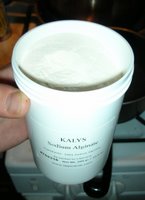 Non-Alliterative Tuesday: no obligations, no rhyme, reason or methodology other than that it's something relevant to food and goings-on in Kitchen Toro...
Non-Alliterative Tuesday: no obligations, no rhyme, reason or methodology other than that it's something relevant to food and goings-on in Kitchen Toro... Recently I ate some tapioca dumplings at a restaurant called Noodle Studio. They were really tasty with an interesting, chewy consistency which I wanted to duplicate. The dough itself was actually slightly sweet and salty-- and the inside had a similar contrast, containing a mixture which I believe was plum paste and nuts. I've also been really excited to try my hand at making fruit caviar using sodium alginate (right) and calcium chloride (right, below).
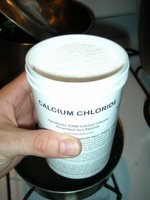 Over the past two days I've been in an experimental mood and made attempts at both the caviar and the dumplings. While I only had some vague instructions about how to make the tapioca dumplings from the chef at the restaurant where I ate them (I should have pressed him for more specific details) I was confident at setting out with the instructions I'd found on willpowder and hungry in hog town. Unfortunately, I didn't have much success.
Over the past two days I've been in an experimental mood and made attempts at both the caviar and the dumplings. While I only had some vague instructions about how to make the tapioca dumplings from the chef at the restaurant where I ate them (I should have pressed him for more specific details) I was confident at setting out with the instructions I'd found on willpowder and hungry in hog town. Unfortunately, I didn't have much success.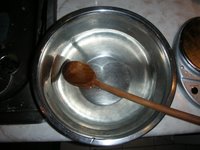 I followed the directions, mixing the calcium chloride and water (in the metal bowl to the left) using the recipe I'd found on willpowder. The required ratio for a calcium chloride bath is supposed to be 6.5 G Calcium Chloride to 1L of Water.
I followed the directions, mixing the calcium chloride and water (in the metal bowl to the left) using the recipe I'd found on willpowder. The required ratio for a calcium chloride bath is supposed to be 6.5 G Calcium Chloride to 1L of Water.The recipe was for a caviar mango in the style of El Bulli and called for mixing:
- 250G Mango Puree
- 250ML Mango Water
- 1.8G Sodium Alginate
- 1.3G Sodium Citrate
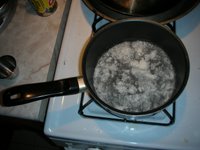 The directions say to bring the water to a boil to dissolve the sodium alginate (left). The powder started gelling up into little gummy trapezoidal shapes. I brought the water to a boil and the gummy shapes were slowly absorbed and the liquid thickened into a gel.
The directions say to bring the water to a boil to dissolve the sodium alginate (left). The powder started gelling up into little gummy trapezoidal shapes. I brought the water to a boil and the gummy shapes were slowly absorbed and the liquid thickened into a gel.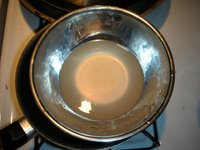 The recipe called for cooling the mixture, which I did (right) and mixing it well. The gel was gooey and didn't taste like much. It was kind of like tasting slime.
The recipe called for cooling the mixture, which I did (right) and mixing it well. The gel was gooey and didn't taste like much. It was kind of like tasting slime.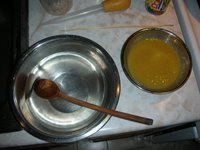 The puree is meant to be added along with sodium citrate. I didn't have mango puree so I substituted pineapple concentrate (right, bowl on left is the calcium cholride bath, at right the sodium alginate mixture with pineapple concentrate). I also didn't have the sodium citrate but having seen other recipes that didn't call for it I just skipped that step. The next step is to drop into calcium solution, allow to set, strain, rinse and reserve cold.
The puree is meant to be added along with sodium citrate. I didn't have mango puree so I substituted pineapple concentrate (right, bowl on left is the calcium cholride bath, at right the sodium alginate mixture with pineapple concentrate). I also didn't have the sodium citrate but having seen other recipes that didn't call for it I just skipped that step. The next step is to drop into calcium solution, allow to set, strain, rinse and reserve cold.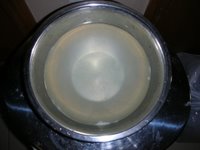 Perhaps the pineapple concentrate had too much acidity, perhaps the puree is needed to give the substance the body the alginate needs in order for the gel to form, perhaps the sodium citrate does have a substantial chemical composition that the gel needs-- I'm not sure exactly what the problem is but the results weren't what I had hoped for.
Perhaps the pineapple concentrate had too much acidity, perhaps the puree is needed to give the substance the body the alginate needs in order for the gel to form, perhaps the sodium citrate does have a substantial chemical composition that the gel needs-- I'm not sure exactly what the problem is but the results weren't what I had hoped for.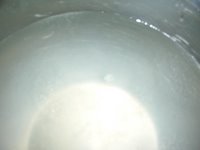 I used a turkey baster to drop the mixture into the bath and also tried letting the mixture run down off a kebab spike and into the bath. Neither strategy worked-- the mixture was supposed to hit the bath and little gel balls would form. Instead the mixture disintegrated. I also tried a calcium lactate bath which didn't work either. I need some counsel from someone who has had success with the process. Time for a break from this experiment.
I used a turkey baster to drop the mixture into the bath and also tried letting the mixture run down off a kebab spike and into the bath. Neither strategy worked-- the mixture was supposed to hit the bath and little gel balls would form. Instead the mixture disintegrated. I also tried a calcium lactate bath which didn't work either. I need some counsel from someone who has had success with the process. Time for a break from this experiment.As for trying to replicate the tapioca dumplings, I tried several methods of making the dough. The chef at the restaurant had said that to make the dough he added a little bit of water to the tapioca and gradually kneeded it until it formed. I think I need a little more information to work with.
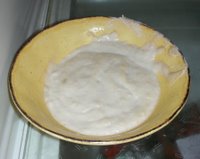 I tried rinsing large pearls, soaking them overnight, and even cooking them and soaking them overnight. The result, at right, was a horrible, white and pasty messy gloopy-glue which I abandoned.
I tried rinsing large pearls, soaking them overnight, and even cooking them and soaking them overnight. The result, at right, was a horrible, white and pasty messy gloopy-glue which I abandoned.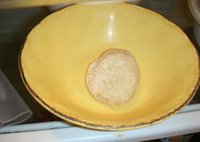 Finally I tried soaking the pearls overnight without having cooked them and then turned them into a paste in the food processor. It was too moist after this so I added flour (tapioca flour which I learned exists might give it the opaque, almost transparent look I'm trying to copy).
Finally I tried soaking the pearls overnight without having cooked them and then turned them into a paste in the food processor. It was too moist after this so I added flour (tapioca flour which I learned exists might give it the opaque, almost transparent look I'm trying to copy).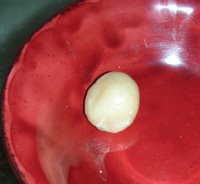 The result, right, were dumplings which while they had a chewiness similar to the opaque tapioca dumplings I'd eated were not as clear as the sakoo at Noodle Studio. I tried filling them with shredded coconut (right) and even ice cream (below). I'd like to make these dumplings a part of the dessert for my final project which includes the Thai Iced Tea ice cream.
The result, right, were dumplings which while they had a chewiness similar to the opaque tapioca dumplings I'd eated were not as clear as the sakoo at Noodle Studio. I tried filling them with shredded coconut (right) and even ice cream (below). I'd like to make these dumplings a part of the dessert for my final project which includes the Thai Iced Tea ice cream.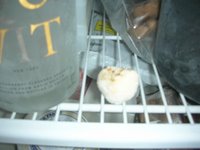 I had problems getting the dumpling to close around the ice cream. Once inside the dumpling dough the ice cream cooled it down too much and it reduced its elasticity and the ability to rejoin.
I had problems getting the dumpling to close around the ice cream. Once inside the dumpling dough the ice cream cooled it down too much and it reduced its elasticity and the ability to rejoin.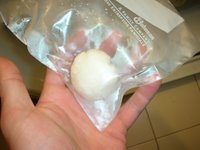 The ball to the right may be the final solution. I skipped the large tapioca pearls and returned to the Kraft minute tapioca. In a small bowl I poured some of the tiny tapioca flakes an then slowly added a little hot water at a time making sure to keep the tapioca dry overall. I kneaded it for a while and put it in the fridge to try to use later, exhausted at my other failures. Another solution may be to just return to the minute tapioca but to soak it without cooking it. One positive that came out of this was that I'm pretty certain that the coconut shred filling won't be enough. I'll have to come up with another filler for the dessert. Back to the drawing board...
The ball to the right may be the final solution. I skipped the large tapioca pearls and returned to the Kraft minute tapioca. In a small bowl I poured some of the tiny tapioca flakes an then slowly added a little hot water at a time making sure to keep the tapioca dry overall. I kneaded it for a while and put it in the fridge to try to use later, exhausted at my other failures. Another solution may be to just return to the minute tapioca but to soak it without cooking it. One positive that came out of this was that I'm pretty certain that the coconut shred filling won't be enough. I'll have to come up with another filler for the dessert. Back to the drawing board...





1 Comments:
keep trying.
could you put fruit inside?
to make it more filling?
can't wait to find out how you solve the puzzle.
Post a Comment
<< Home